ARM A53/A57/T760 investigated - Samsung Galaxy Note 4 Exynos Review
by Andrei Frumusanu & Ryan Smith on February 10, 2015 7:30 AM ESTGPU Performance
In the graphics department we're matching up Qualcomm's Adreno 420 versus the Mali T760MP6. The Adreno is running at 600MHz and is able to benefit from almost double the memory bandwidth at 25.6GB/s versus 13.2GB/s due to the Snapdragon's increased 128-bit memory interface. Let's look at how both compare in our overall benchmarks:

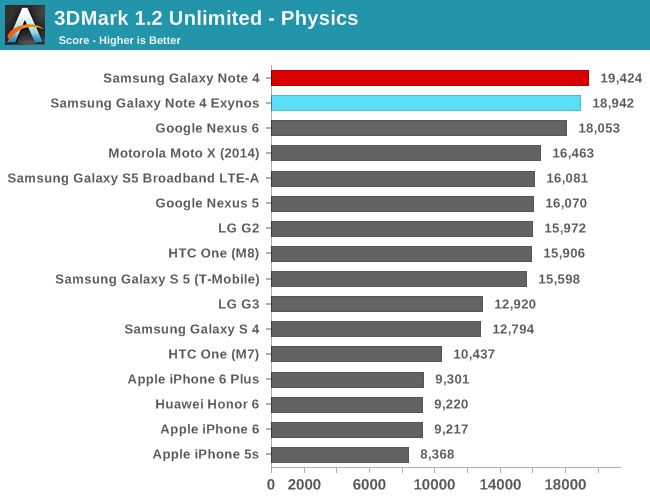
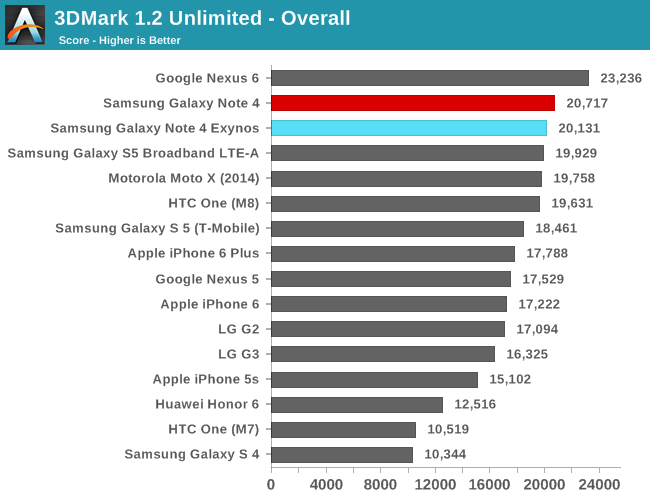
In 3DMark Unlimited the Exynos version comes just short of a few fps behind the Adreno 420. What is also surprising is that the Exynos 5433 performs much better in the physics score than I had anticipated; the same test on Huawei's SoCs limited the thread onto the little cores in the default settings giving mediocre performance results. However, it seems the A53 is performing much better and is able to match Qualcomm's offering now.
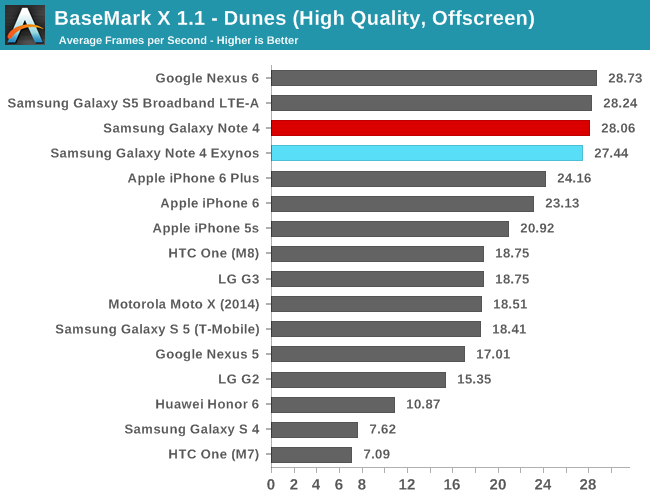
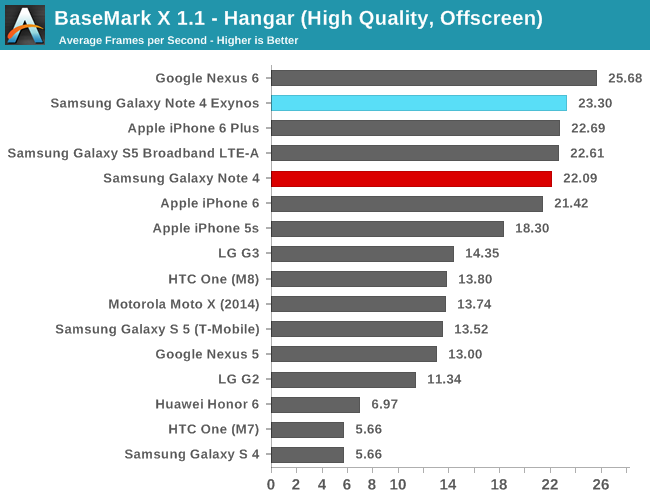
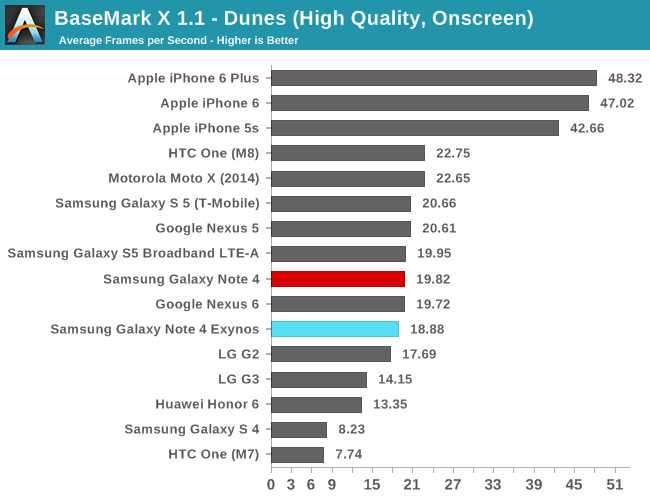

In BaseMark X 1.1, the Exynos is again neck-and-neck with the Snapdragon version. It loses by a slight margin in the Dunes benchmark while winning in the Hangar scenes by a similarly small margin. BaseMark X is again one of the benchmarks that can trigger the 700MHz state of the Mali GPU, offering higher performance at a much higher power draw depending on which scene is currently rendered on both tests.
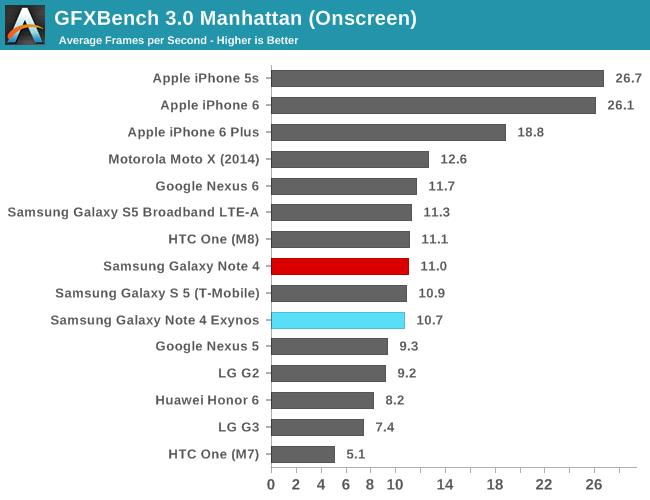
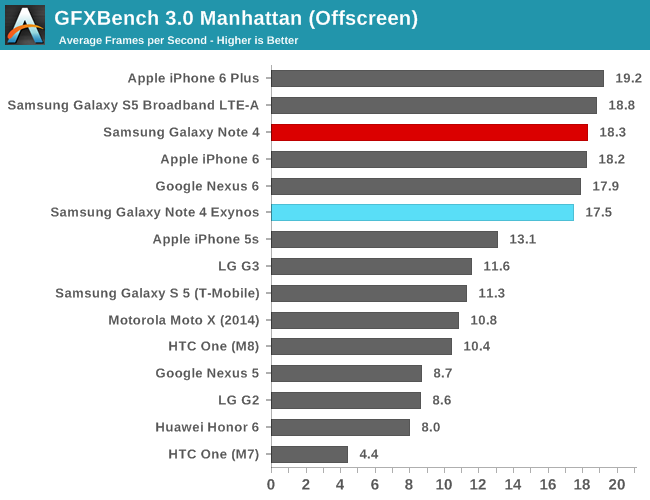
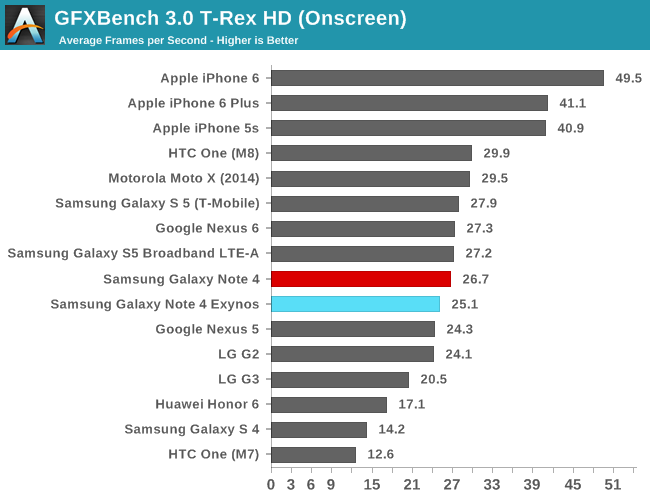
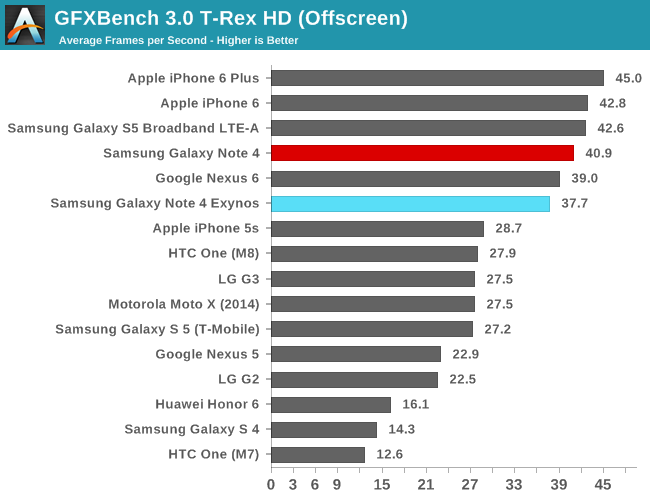
Again we continue to see the same pattern in GFXBench's scenario benchmarks, with the Exynos version lagging a few frames behind the Qualcomm GPU in both Manhattan and T-Rex, in both on-screen and off-screen results.
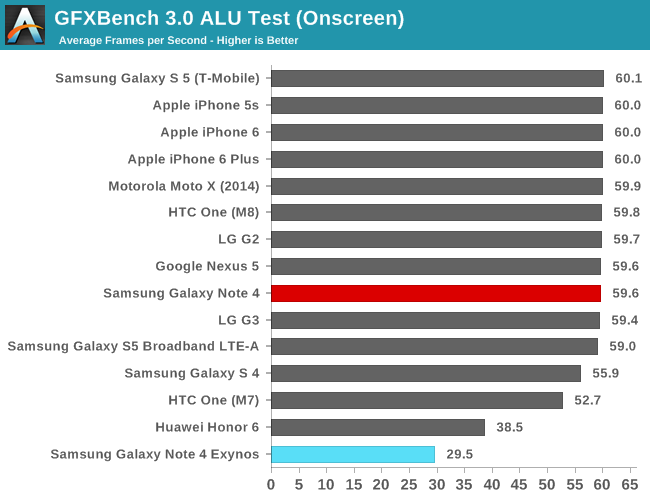

It's on the synthetic tests that we finally see some major deviation between the two architectures. ARM's Mali simply can't seem to keep up with the ALU throughput of Qualcomm's architecture. Both the Adreno 330 and 420 have a clear computational power advantage, exceeding even Imagination's PowerVR GPUs in the iPhones, leaving Mali strictly on the lower end of the performance spectrum.
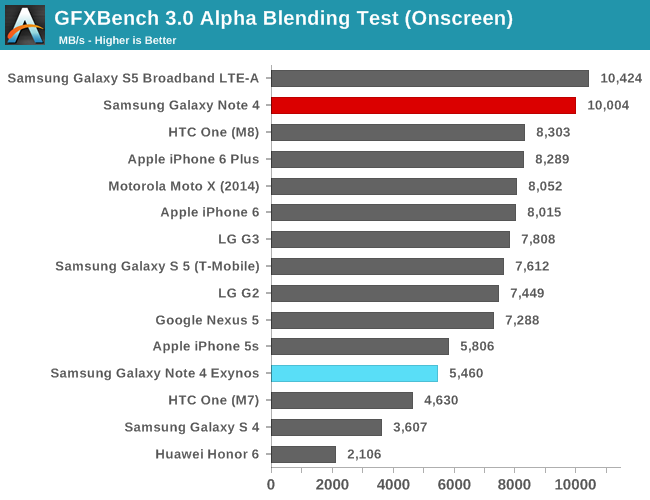
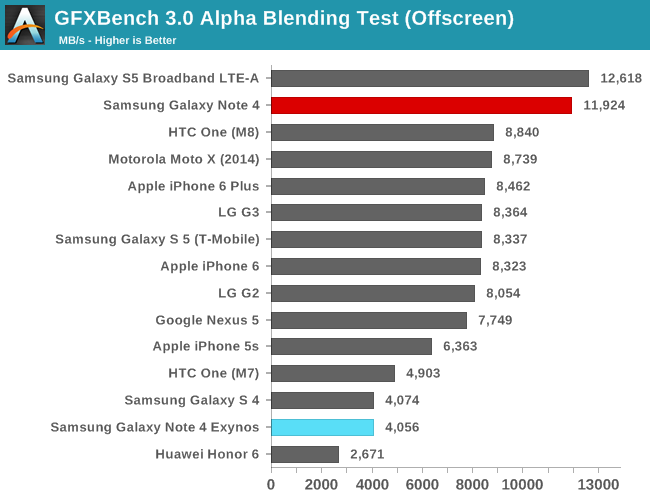
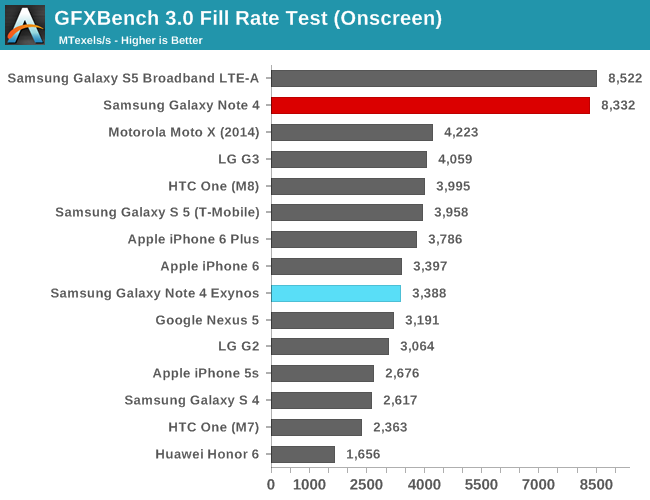
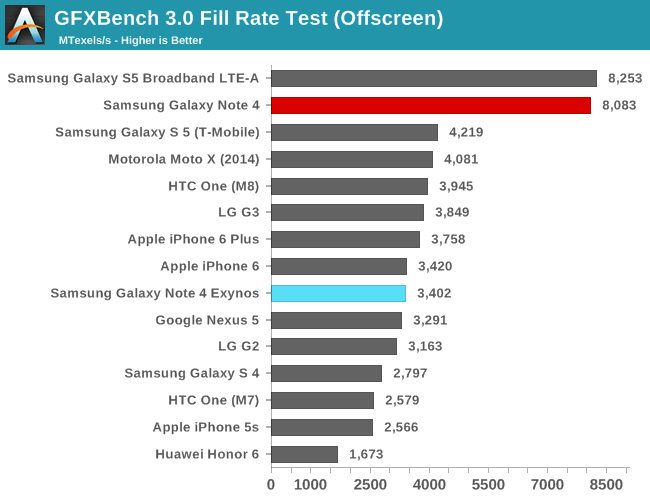
We see a similar situation in the Alpha Blending and Fillrate tests, as the Adreno offers 2-3x the throughput. Utilizing the extra memory bandwidth here seems to be key to the success of the Snapdragon 805's graphics performance.

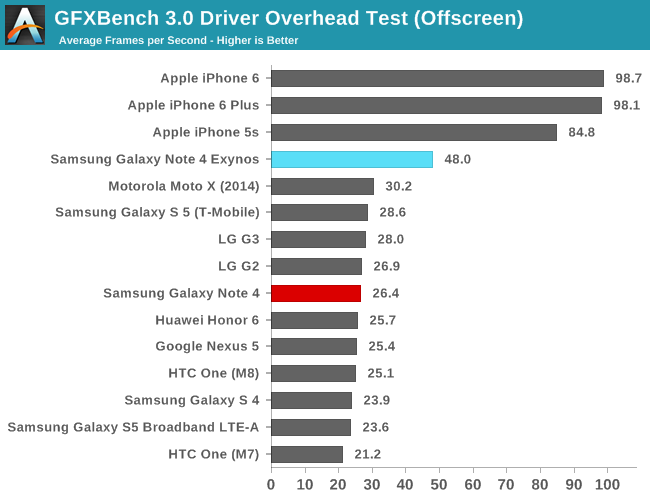
I've already mentioned the Driver Overhead score in the the more in-depth analysis of the T760. It's the first Android device to truly stand out from the rest of the crowd, finally making some progress into trying to catch up with Apple's excellent performance on iOS. Here's hoping more vendors concentrate on improving this metric in future driver updates.
I did some extensive power measurements on the Note 4 Exynos in this review, so naturally we're keen to see how this transforms into our battery benchmarks on the next page.










135 Comments
View All Comments
tipoo - Tuesday, February 10, 2015 - link
Agreed, it was a little shocking to see that even the Cortex A57 is stomped on by the A8/Cyclone R2. And that with two cores and sane clock speeds.I would say this is what everyone else would be doing, ideally, but the cost here is die size. Instead they shoot for smaller higher clocked designs to save some die size and cost, since other companies aren't willing to pay as much for the SoC in the BoM as Apple is.
ruggia - Tuesday, February 10, 2015 - link
to be fair, the basic minimum performance Cyclone R2 have had to achieve was beat A57, since that was the reference design available from ARM for everyone. So I don't think it's that surprising.tipoo - Tuesday, February 10, 2015 - link
On the other hand, them and Nvidia alone have parts better than the A57 per-core out, and even from those two the 64 bit Denver K1 is too high in power draw and chokes on some tasks due to its code morphing engine bottlenecking the process.So it is still remarkable, to me, how early and how long Apples lead has lasted.
Kidster3001 - Friday, February 27, 2015 - link
Why do we need octa cores in phones/tablets? Marketing says we do, plain and simple. It's bragging rights. No real benefit but it sounds cool. Apple is doing it wider and smarter.DarkLeviathan - Saturday, December 19, 2015 - link
But unfortunately people are getting dumb-er and stupid-er (XD). Falling into marketing ploys. I feel like Apple is the one who is not marketing crazy now. Its all numbers with the Android people :/ Apple cares about user experience more than any other companies and they spend a lot more money on it.xdrol - Tuesday, February 10, 2015 - link
Please go compare it to nVidia Denver cores.tipoo - Tuesday, February 10, 2015 - link
I have. It wins some benchmarks, but is less consistent in the real world because it's a code morphing design that can get choked up by unpredictable code. It's also more power hungry, though that's partly the fab.lilo777 - Tuesday, February 10, 2015 - link
bigstrudel, you are either Apple fanboy or a troll. For your own sake I hope it's the former and you understand that what you posted is pure nonsense. The only tests where iPhone dominates Samsung phones are specint and basemark tests. But the reason for that is not what you probably think it is. Specint benchmarks use only one core. Sure, A8 core is faster but then iPhone has just two of them. The total power of four cores is higher than that of two A8s. And it's not like the two A8 cores consume twice less power than four Samsung cores. A8 is a very BIG core. Each A8 core uses more power than a single Samsung core. And basemark scores... Those depend on screen resolution and iPhone has a very low resolution compared to Note 4. In short, both approaches (two large cores or big.LITTLE architecture) have pros and cons. There is no magic here. It is not clear to me why would you say that A8 "stands light years ahead" when the phone based on this SOC (iPhone 6) lags high end Android phones in synthetic benchmarks like Geekbench.DarkLeviathan - Saturday, December 19, 2015 - link
1. The CPU and resolution has almost nothing in which you can compare with2. If you do a little research and stop drinking that Samsung marketing soup, you would realize that not all the Samsung cores are not the same. They vary in power...
PC Perv - Tuesday, February 10, 2015 - link
Apple A series is already eclipsed by Exynos 5433 as seen by sub-test scores in Geekbench. (how does Geekbench calculate aggregate score? I have no idea) A8 will also be crushed and humiliated by soon-to-arrive Exynos 7420.Dual-core is the best configuration? My ass. That is why they added another core in the new iPad. Oh, if you look at the die shot there is a space for a 4th core there, too.